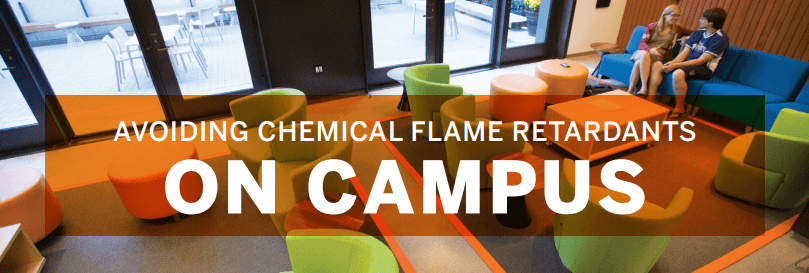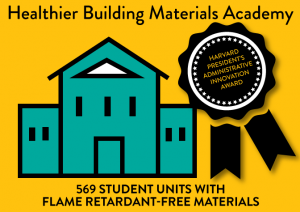Scientific findings are a driver for change. However, it is common that the time it takes to implement such changes is much longer than necessary. An integral part of our program’s mission is to catalyze the adoption of commercially available solutions proven to diminish the burden of toxic chemical exposures. To do so, we have engaged with higher educational institutions, research organizations and other key stakeholders to promote healthier product choices in our buildings and beyond them.
The best example of this engagement is our relationship with the Harvard Office for Sustainability (OfS). OfS has taken findings directly from our research and has spearheaded a movement to reduce the exposure to endocrine disrupting chemicals, primarily among young students, who are particularly vulnerable. OfS leadership has joined with other powerful institutions to send market signals that switching to green alternatives in furniture and material finishes is the right, and desired, thing to do. Find below our work in the field of translating science into actions, and other funded activities:
Research and action on campus about chemicals of concern
Harvard Healthy Buildings Academy
The Healthier Building Materials Academy brings the University’s decentralized project management and purchasing community together with our external vendors to create a pathway for reducing the use of certain chemicals of concern in the University’s capital projects. Working in partnership with Harvard faculty experts, the Academy creates a structure for better understanding the science, regulatory environment, and market opportunities for addressing chemicals of concern in the built environment.
Detox Me Action Kit
Our program actively took part in the Silent Spring Institute Detox Me Action Kit, a collaborative biomonitoring study aimed at assessing people’s exposure to common household and environmental toxins. In particular, we supported the research paper titled “Influence of living in the same home on biomonitored levels of consumer product chemicals.” This study focused on investigating the impact of sharing a home on urine levels of ten phenolic chemicals found in various consumer products.
Past work on flame retardants:

Our Program worked closely with Silent Spring Institute to change the fire codes in Cambridge and Boston (read more). Flame retardants escape from products and settle into dust that can be ingested or inhaled. According to the Silent Spring Institute, Americans have some of the highest measured levels of flame retardants in their blood in the world. In 2003, their researchers reported that levels of flame retardants in U.S. homes were ten times higher than in Europe. These harmful chemicals are linked to cancer, reproductive harm, reduced IQ, developmental delays, and obesity (Read our publication from this work)
More Links
- Boston changes fire code to allow furniture free of flame retardants in public spaces: On March 23, 2016, the Boston City Council passed a bill amending the city’s Fire Prevention Code, allowing hospitals, schools, colleges, and other public buildings with sprinkler systems to use furniture free of toxic chemical flame retardants. READ MORE
- Harvard furniture purchase policy: Driven by research, Harvard joins industry leaders like KaiserPermanente, Facebook and Autodesk pledging to purchase furniture without toxic chemical flame retardants. READ MORE
- Flame retardant free toolkit: a decision tool to select chemical flame retardant free furniture. READ MORE


